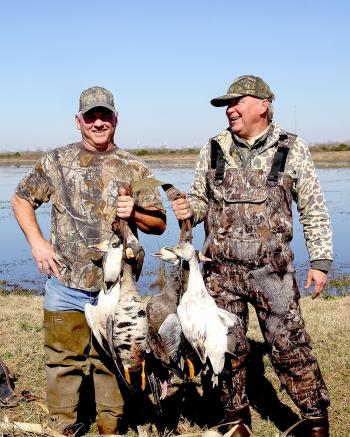
Local hunters Eddie Darce Sr., left, and Mark Gowan smile following their morning in the rice field on U.S. Fish and Wildlife Service property. (Submitted Photo/Courtesy of John K. Flores)
Flores’ 2014 resolution: Hunt Public lands more
Hunkered down in a pit blind, we tried to get as small as we could where two speckle-belly geese, turning to my enticements, wouldn’t see us.
Really a novice when it comes to calling geese, the soft clucks I made did the trick, fooling them.
And now the moment of truth was mere seconds away.
The oncoming birds made a slight veer to the left but still close enough to the blind where we could count the spots on their breasts.
“Take-em!” I said.
The three of us rose out of the pit like zombies from a grave after drinking Red Bulls — the quick and the dead. Only, the geese laying on the water surface were the dead.
And, celebration ensued.
Why not? My two partners and I weren’t on a fully guided hunt. We weren’t on a private lease or even exclusive rod and gun club. We were high-fiving, because we were hunting waterfowl on public ground.
Put another way, when you combine U.S. Fish & Wildlife Service property, U.S. Forest Service property, U.S. Army Corps of Engineer land, National Park Service acres and Louisiana Department of Wildlife and Fisheries land, we were hunting just a small piece of 3.3 million acres or 9.7 percent of the total land acreage in Louisiana available to hunters.
In short, never should it be said there is no place to hunt when it comes to the Sportsman’s Paradise.
Louisiana Department of Wildlife and Fisheries lands alone make up 1.4 million acres of the total available to hunters. The department owns and manages 52 Wildlife Management Areas, or WMAs.
And when it comes to hunting on these state lands, 76 percent of the time it’s deer hunting, which turns out to be higher than all other WMA uses combined, according to Steve Smith, WMA Program Manager.
“There’s a ton of land out there actually,” Smith said. “And our 52 WMAs comprise a lot of that acreage. Twenty one percent of deer hunters statewide utilize our WMAs. And when comparing us to other states in the southeast around us, we have nearly twice the acreage and much higher user days.”
When comparing states like Alabama and Mississippi, who track acreage and user days like Louisiana, Smith utilizes a power point presentation to make comparisons that are surprising.
Alabama has 775,000 acres of land available to the public with an estimated 160,000 (hunter only) user days. Mississippi has 665,000 public acres with 227,000 combined activity user days.
By contrast, when looking at Louisiana’s 1.4 million managed public acres, there are 680,000 user days.
Both Arkansas and Texas, who have 754,000 and 770,000 acres of public land available, respectively, do not collect use data. But, both of these states still have far less acreage available compared to Louisiana.
According to a recent LDWF press release, 25,360 hunter efforts were tallied in 2013 on 37 managed units. Total deer harvested on these units totaled 2,651 — 1,322 were bucks and 1,329 were does.
Use of Louisiana’s public lands isn’t limited to deer hunting. Thirty-three percent of all waterfowl hunters hunt on the state’s WMAs.
Of the 23,000 turkey hunters in Louisiana, 25 percent utilized public land in 2013.
And besides hunting, there is also fishing and non-consumptive uses, such as shooting, sightseeing, camping, hiking, dog training, photography and birding.
What was unique about our waterfowl hunt was it was one of the state’s many lottery hunts available to the public each year. Lottery hunts, both deer and waterfowl, typically offer youth and adult hunters exclusive access to a blind or stand on prime acreage set apart from other public lands on the WMA or refuge where they occur.
Lottery hunts can be stellar and unforgettable. On our hunt, the weather conditions couldn’t have been worse when it comes to waterfowl. The moon was full, which typically finds ducks and geese feeding in agricultural fields at night. There was a low morning fog that often causes ducks to be on lock down. Zero breeze and wind caused the rice field pond to look like a skating rink, with absolutely no movement in our decoy spread.
And finally, by 8:30 a.m., when the fog lifted, it became a bluebird day.
Still, we managed six geese, both white-fronted and snows, and three ducks. Those aren’t big numbers but nothing to sneeze at either.
Anytime a group of guys harvests nine birds in a morning under those conditions, it’s something to brag about.
With the New Year upon us, and many folks mulling over resolutions, one I suggest for 2014 is to hunt public land more and take advantage of some of the amazing lottery hunts. You won’t be disappointed.
If you wish to make a comment or have an anecdote, recipe or story to share, you can contact John K. Flores at 985-395-5586 or gowiththeflo@cox.net or visit www.gowiththeflooutdoors.com.
- Log in to post comments
